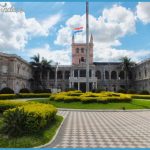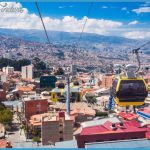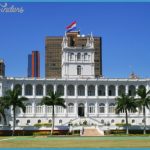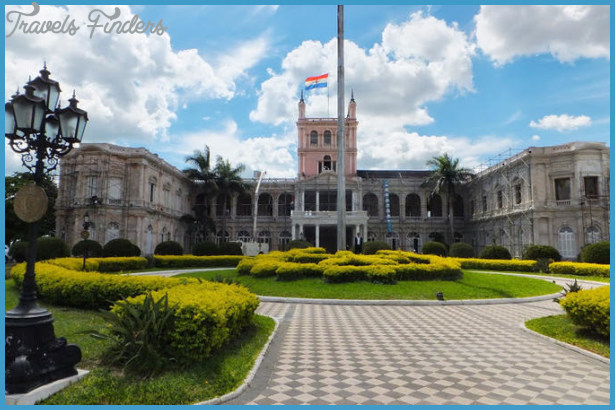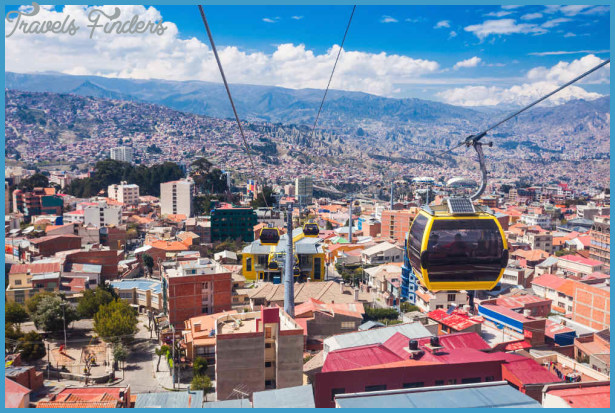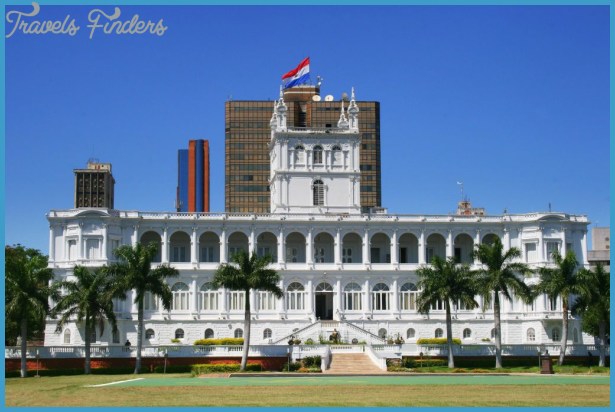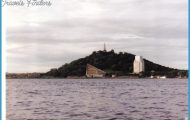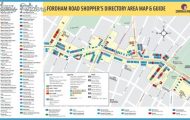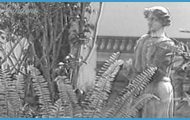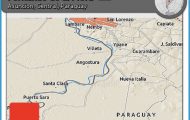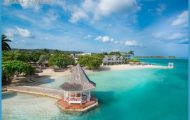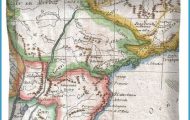The majority of Asuncion’s historic sites are located in the downtown area. Much of the colonial downtown is gone, but there are still some remaining structures that recall an era of yesteryear in Asuncion. Many of these date from the rule of Carlos Antonio Lopez when Paraguay was at its height of economic wealth.
Start at Palma and Colon. To get there by bus, take Linea 12, 26, 56 or any bus with a “Pdte Franco/Palacio Justicia ” sign. These run down Presidente Franco and turn on left, on Calle Colon -you can get off either at the corner of Presidente Franco and Colon or Colon and Estrella. Or if you’re nearby, simply walk down Calle Palma where you will see Paraguay’s street vendors in full force lining the street with stands selling delicate nanduti designs, indigenous crafts, knockoff sunglasses and pirated DVDs.
Walk towards the river (downhill) along Calle Colon. To the right-hand side is “ La Recova,” a historic building now shared by the Paraguayan armada and a number of handicrafts stores (the former section is much better restored than the latter). Note the original tiled floors in most stores. This is a great place to buy a wide variety of artesamas and have a calmer shopping experience than at the stands in the Plaza de Democracia or along Calle Palma.
Walk towards Presidente Franco. Directly in front you will see the Port of Asuncion and a metal sculpture by renowned artist Hermann Guggiari – take a right. For a quick snack, stop at either the Fiambreria Ochsi (short ribs, small sandwiches, and beer) on the corner of Presidente Franco and Montevideo (Mon-Fri 7:30am-11:45am & 2:30pm-7:15pm, Sat 7:30am-1pm) or German bakery Michael Bock (breads and pastries) further down Presidente Franco (number 828).
On Ayolas, take a left and head towards the river – walk alongside the Palacio de los Lopez Presidential Palace down to the Canonera Humaita Naval Museum located in the ex-battleship, Humaita (Mon-Fri 8am-11:30am, Sat 2pm-6pm, Sun 8am-6pm). From here you can best admire the Bay of Asuncion and even see the southernmost tip of the Paraguayan Chaco to the northwest. You can also see the Palacio de los Lopez (Presidential Palace) as it was meant to be seen by visitors as they entered the Bay of Asuncion by riverboat. Note: Pedestrians are not allowed along the side of the Presidential Palace that extends past Juan E. O Leary.
Returning along Ayolas, stop at the Plaza de los Desaparecidos (Plaza of the Disappeared). On the right you’ll see a statue of Stroessner that has been broken apart and encased in a large cement block, representing the oppression of his dictatorship. From here, visit the Manzana de La Rivera on the corner of Paraguayo Independiente and Ayolas (the entrance is on Ayolas). This complex of colonial houses has been restored and is now home to Asuncion’s municipal cultural center which includes a nice two-story library and the Museo de la Ciudad whose small but well curated exhibits provide visitors information on colonial Asuncion. After visiting the museum, head to Casa Clari, the center’s bar, to enjoy an excellent view of the Presidential Palace (and, if you’re lucky, a bit of a breeze from the river).
Exiting the Manzana de la Riviera, head left up Ayolas and take a left on Presidente Franco. A couple of houses down you’ll pass the Casa Fratta on your right. This art nouveau style building has been both a photography studio and a pharmacy in the past and, though deteriorating, it’s a great example of Asuncion’s many architectural gems. Remain on Presidente Franco for three more blocks until you come to the corner of 14 de Mayo. (Alternate: If architecture is your thing, and you’d like to see one of Asuncion’s cool buildings in better condition, take a right on O’Leary and then continue to the left on Calle Palma past 15 de Agosto. On your right you will see the well maintained Casa Costas (Palma 561), built in 1915.) Take a left on 14 de Mayo and enter the Casa de la Independencia (Sat 7am-6:30pm, Sun 8am-12pm) on the corner with Presidente Franco. It is from this very house, one of the few remaining colonial houses of Asuncion, that the plan to declare independence from Spain was hatched. The house was restored and converted into a museum dedicated to the fathers of Paraguayan independence.
Continue down Presidente Franco and pass the Teatro Municipal (Municipal Theater) on the corner of Alberdi – though the box office does not open till 4:30pm you can check out the posters for upcoming events and peek inside the lobby of this handsomely restored building. You can also ask to see the theater itself which is quite nice.
If you are ready to eat, there are several good options nearby:
Classic Asuncion diner, Lido Bar (continue on Presidente Franco till Chile and then take a right to the corner of Calle Palma), boasts some of the best caldo de pescado (fish soup) around and is very popular with foreigners and locals. Part of the sport of eating at Lido is hovering behind customers finishing up at the bar in order to grab their seats – worth the bother to see all the waitresses swirl past each other in their bright orange outfits. The fancier Bolsi Bar (head up Alberdi to the corner of Estrella) has an excellent menu of international cuisine (and air conditioning). Or if you’re just in the mood for a snack, check out Na Eustaquia (corner of Alberdi and Palma) for classic Paraguayan fare such as mbeju and chipa ryguazu as well as fresh juices.
Visit the Panteon de los Heroes directly across the street from Lido Bar. If you want to look at more handicrafts, walk to the plaza behind the Panteon and check out the artesama stands. Prices are good and, although it can be a little cramped, it is safe. Now that you have your terere rupa (pre-terere snack) you can pay one of the plaza’s yuyeros to rent all the requisite equipment for a terere session before sallying forth. (see alternate route below.) Head back towards the river along Nuestra Senora de la Asuncion (running through the middle of the four plazas) to the large pink Museo del Cabildo (on the far side of the plaza Juan de Salazar) featuring exhibits of Asuncion’s history as well as exhibits from three other prominent museums. One should take extra precautions in this area, as it’s near one of the city’s poorest slums, the riverfront Chacaritas neighborhood. To the left you’ll see the National Congress, its modern architecture, vaguely reminiscent of a cruise ship, standing in stark contrast to the 19th century museum. The plaza between the congress building and the Cabildo is dominated by a four ton metal tree trunk breaking through chains, sculpted by Hermann Guggiari.
Take a quick peek inside the Catedral Metropolitana, Asuncion’s main cathedral, for a look at the ornate altar piece decorated in a style known as “Barroco Fransiscano-Guaram.” If you are doing this tour in reverse and are interested in religious art, you can also stop by the Museo Juan Sinforiano Bogann (only open till 11:30am) alongside the church.
From the cathedral walk up Independencia Nacional to Mariscal Estigarribia and take a left – the street will then “T” out into Plaza Uruguaya, a shady plaza where people relax and drink terere (though it is often occupied by indigenous protesters). Take a left and head to the Museo Ferroviario for a look at one of the first steam trains in Latin America. The museum is housed in Asuncion’s now defunct central train station (Tues -Fri 9am-5pm, Sat-Sun 9am-1pm).
Those interested in Paraguay’s various indigenous cultures should continue down Mariscal Lopez (behind the museum), take a left on to Tacuary and the next right onto Espana to get to the Museo Etnografico Andres Barbero (8am-5pm).
If it is afternoon, head back down Mariscal Estigarribia to grab a drink at the Cafe Literario, modeled after European literary cafes (open from 4:30pm onwards), or Planta Alta (5pm onwards), the bar/contemporary art gallery popular with Asuncion’s artsy crowd.
An Alternate Route
From the Panteon de Los Heroes continue up Chile (away from the river) until Haedo, and take a right. On the corner you will see Farmacia El Ciervo, another example of Asuncion’s quirky older buildings. Continue along Haedo to the Iglesia de Encarnacion (as of 2010 undergoing restoration) on the corner of 14 de Mayo. (Mon-Fri 7am-11am and 4pm-9pm). Though less visited then Asuncion’s main cathedral, this church does have some nice stained glass windows.
Continue up 14 de Mayo four blocks and take a left on Jejui. Walk two more blocks and take a left onto Chile. Enter the Museo Memorias de la Dictadura on the left-hand side (Chile 1066, Mon-Fri 9am-4pm). Housed in what was, until the 1990’s, a clandestine police holding area, this small but powerful museum details the human rights abuses of the Stroessner era.

